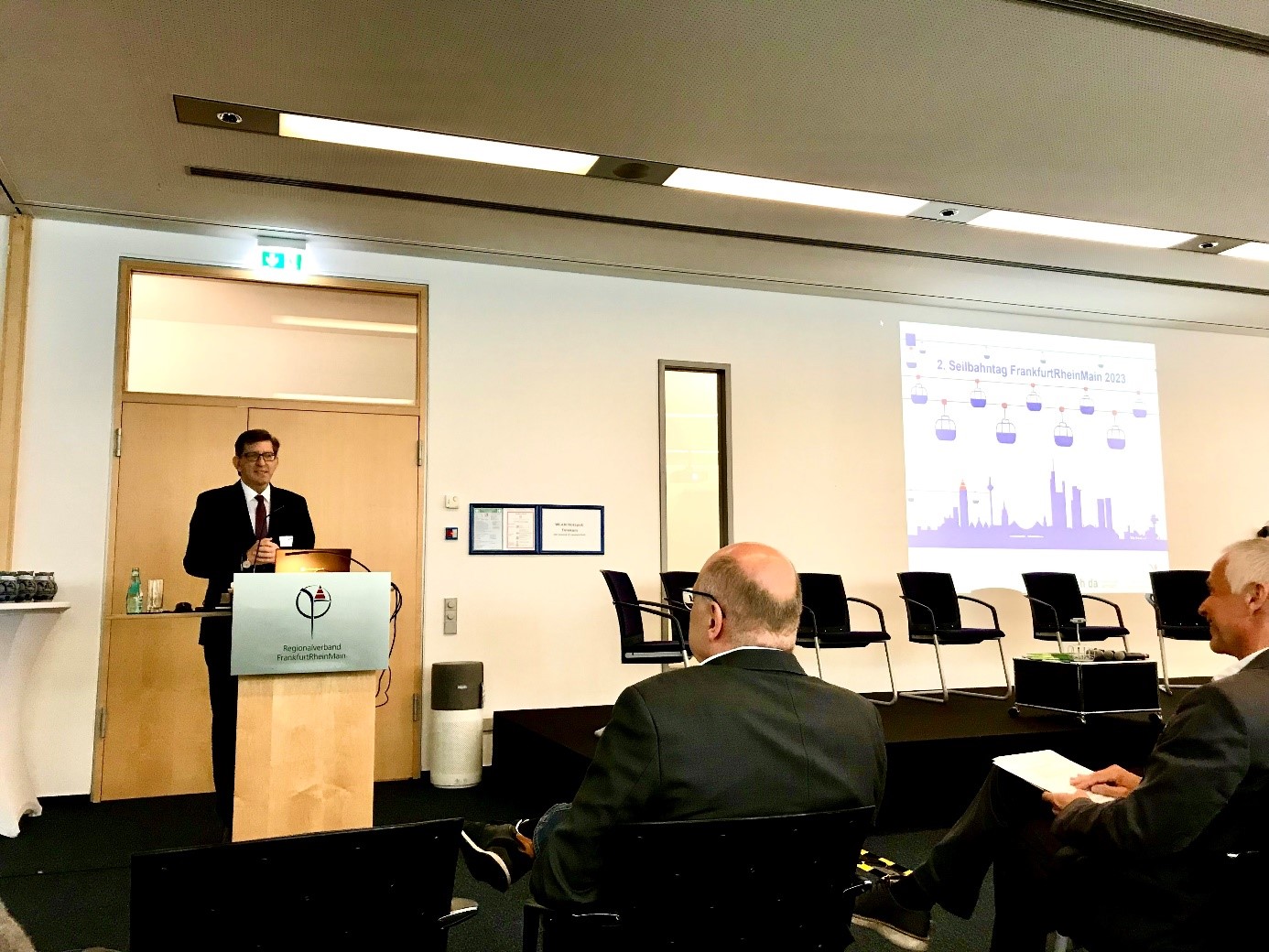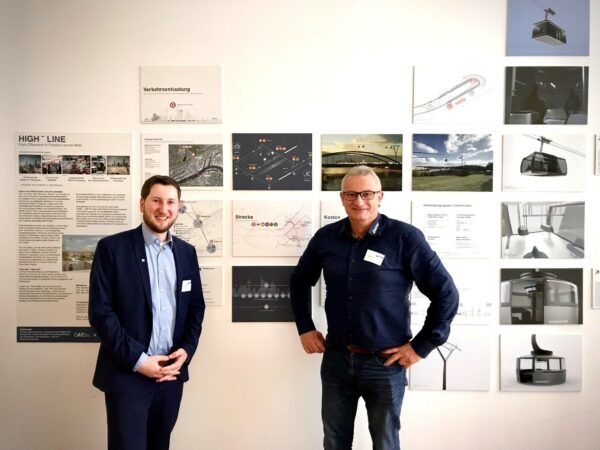
Cities, SI-Urban
Review of the 2nd Ropeway Day
Are projects like those in France or Amsterdam a good model for FrankfurtRhineMain? To what extent can ropeways offer solutions for the increasing traffic and commuter flows in this boom region? And what advantages does this mode of transport offer in terms of planning times and ecological footprint?
These key questions determined the conference program, which was rounded off by an exhibition of the Darmstadt University of Applied Sciences (hda) in cooperation with the Offenbach University of Applied Sciences (hfg). Prof. Dr. Jürgen Follmann from the hda, a thought leader for urban ropeways in Germany, led the day as moderator on the premises of the regional association.
After the introductory and motivating words of the association’s director Thomas Horn, Sebastian Beck (Drees & Sommer) explained the background, contents and purpose of the recently published federal guideline for the application of urban ropeways in Germany. He referred to the individuality of infrastructure projects, which a guide cannot cover.
Rather, this guide serves municipalities as an introduction to the topic, which is still uncharted territory for many. In addition, recommendations for action were addressed to the Federal Ministry of Transport in the course of developing the guidelines, which refer to existing hurdles. Afterwards, Patrick Vial (Tisséo Collectives), probably the participant who had traveled the furthest, showed how all hurdles have already been overcome in France. For the past year, passengers in Toulouse have been able to ride an urban ropeway, as they have already done in Brest or St. Denis.
As project manager of the Toulouse ropeway, Patrick Vial is currently being used by many French cities as a contact to promote their own projects. After his insight into the Toulouse project, Christoph Rittersberger (Transdev Rhein-Ruhr) continued with a contribution from the operator’s perspective. Transdev is already operating ropeways in France and South America, has been awarded the contract for the planned Paris ropeway, and is currently pushing ahead with many projects in Germany, said Rittersberger.
Before the lunch break, Han Joosten (BPD Immobilienentwicklung GmbH) addressed the auditorium with strong words of opinion and wished for a bit more experimentation and (Dutch) pragmatism from German cities.
For him as an area developer, the development issue is of great importance and can decide the weal and woe of large projects. This is why ropeways have moved into the focus of bpd as an option to develop new areas in a cost-efficient and sustainable way.

Dominik Berndt (Cable Car World) and Edgar Welti (REMEC) in front of the HIGH¯LINE info wall.
After lunch is before coffee! In the second block, Jürgen Heinzel (UN Studio), Helmut Wiesner (Bundesstadt Bonn) and Mathis Lepski (PwC) gave insights into their work on the topic of urban ropeways. As an architect and designer, Jürgen Heinzel is concerned with the design of station buildings and supporting structures for ropeways. In cities, completely different requirements have to be met than in the mountains.
In particular, the “Ijbaan” project in Amsterdam is currently well advanced, including designs by UN Studio. There is fundamental agreement among all the players, but a number of questions still need to be clarified before the final green light can be given. The same applies to the Federal City of Bonn, whose project genesis and state of affairs was presented by the head of the transport department, Helmut Wiesner.
At the moment, there is a lot of coordination going on in the background, but basically the city is on the right track and could become a pioneer in Germany if the first real urban ropeway can actually go into operation in Bonn.
With the HIGH¯LINE from Offenbach to Frankfurt?
In the last block – after the well-deserved afternoon coffee – the perspectives were put on the regional university landscape. The idea of a ropeway between Offenbach and Frankfurt was brought into focus. It operates under the slogan HIGH¯LINE and is intended, among other things, to cross the Main River and connect several public transport stations.
The accompanying exhibition has also taken up this idea and visualized it with vivid posters and models (More info: HIGH¯LINE – Offenbach Institute for Mobility Design (oimd.de)). Prof. Peter Eckart and Daniel Rese from hfg explained their approaches before Thomas Marx from hda continued with perspectives for the region.
Finally, a large panel came together for a panel discussion. Prof. Follmann put his questions to Kai Dietl (traffiQ – Lokale Nahverkehrsgesellschaft Frankfurt am Main mbH), Sebastian Heller (Rhein-Main-Verkehrsverbund), Georgios Kontos (Regionalverband FrankfurtRheinMain), Thomas Marx (hda), Daniel Rese (hfg), Maximilian Rohs (PwC) and Michael Rüffer (Verkehrsgesellschaft Frankfurt am Main – VGF).
In the lively discussion, it once again became clear that urban ropeways have not yet reached all transport planners and municipal decision-makers as a genuine public transport option. A lot of educational work and events like this one are still needed to show the possibilities and potentials of urban ropeways.
In the FrankfurtRhineMain region, considerations to date (also due to the pandemic) have not yet progressed far, so that the participants have taken new momentum from the event to push the topic forward again.
The next regional initiative will take place in Mannheim on June 15, 2023. The VRN ropeway day there will have a slightly different focus. SI will also be there and will report. Register now for Mannheim: VRN | Der VRN-Seilbahntag, 15. Juni 2023







